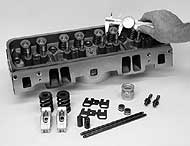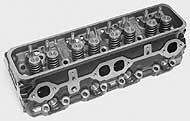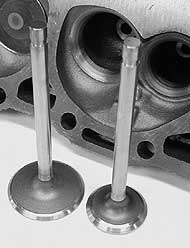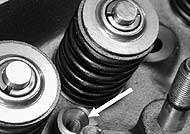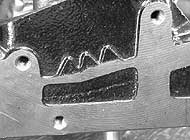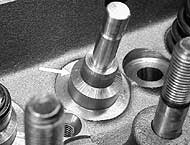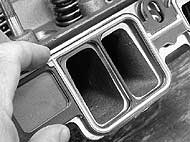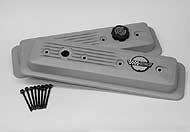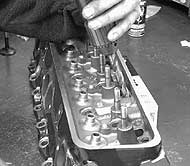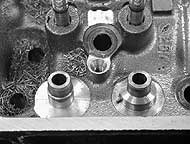| PART PRICES |
| GM & GC PARTS |
| Crate Engines |
| Stock |
| Performance |
| Gen 3 & 4 |
| Partial Engines |
| Bare Blocks And Parts |
| Cylinder Heads And Parts |
| 2.4L Twin Cam Supercharger |
| Gauges And Parts |
| Plugs, Wires, And Looms |
| Camshafts And Parts |
| Chrome Parts Made by Proform |
| Distributors And Parts |
| Valve Covers And Parts |
| Starters & Parts |
| Intake Manifolds And Parts |
| Transmission And Parts |
| Engine Oiling System Parts |
| Suspension Parts |
| Shocks And Shock Kits |
| Brakes And Brake Parts |
| Ehxaust Systems |
| AFTERMARKET |
| MSD IGNITION |
| FLUIDAMPR |
| HOLLEY |
| AFR |
| PROFORM |
| RICHMOND |
| R&M |
| B&B |
| ACCEL |
| SCAT |
| EDELBROCK |
| DEMON |
| HUGHES |
| TREMEC |
| Help |
| VEHICLES |
| NOTES |
| Please make sure you have your e-mail address on all of your messages sent to us. |
| If you have been told by your local dealer that a stock part has been discontinued, asking us the same question will not change that fact. |
| The GM high performance discussion board is mainly for our customers to get together and communicate, but it is also for communication with us. |
| Chevrolet - GM L31 VORTEC CYLINDER HEADS AND PARTS TO USE WITH THEM |
|
GM SBC 350 CI Vortec L31 Heads and compatible parts for the Vortec Heads. This production Vortec iron cylinder head was first used on the 1996 pickup truck RPO L31 with fuel injection. America’s favorite high performance cast iron small block cylinder head offers big power and bigger value. Keys - gmhead, gmheadpart |
| WEB SITE NAVIGATION INFORMATION |
| If you have you just came from a search engine and are stuck with no navigation, turn on Java Scripts in your Web browser, reload the page, then you can turn off Java Scripts again. Also, people using Internet Explorer have to use the pull down tab next to the back button to return to a search engine. More information on this is on our help page. |
| GM and Chevrolet part prices are in the Price & Parts search. Keys are to be used with the Price & Parts Search. Enter a Key, part number, GM, SC, or a key word, like 502, into the Price & Parts search to see if we have it on our site. Use GM for a list of both GM and GMPP parts. Use SC for a list of all Chevrolet exclusive parts. Aftermarket company prices are on downloadable Price Sheets or on their pages. The Page Search is for searching the pages of our Web site. More information on this is on our help page. |
| CYLINDER HEAD NAVIGATION |
| GMPP CAST IRON VORTEC HEAD ASSEMBLY |
| P/N 12558060 L31 350 Vortec Cylinder Heads (See options below.) | |
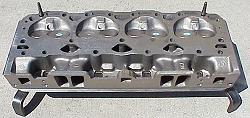  |
 |
| Small block Vortec heads, the head with huge performance gains that everyone is talking about. | |
|
This production Vortec iron cylinder head was first used on the 1996 pickup truck RPO L31 with fuel injection.
The intake and exhaust port are very similar to Corvette 350 LT1 heads. America’s favorite high performance cast iron
small block cylinder head offers big power and bigger value. The Vortec cylinder head's fast burn combustion chamber
and high velocity ports combine to produce big horsepower out of the box. The Vortec head can be mildly ported for
additional performance and can be milled up to .040” for increased compression ratio. This head includes 1.94” intake
valves and 1.50” exhaust valves, springs and retainers, and pressed-in 3/8” studs. This head with compatible valves
flows more air than bow tie head P/N 10134392, but the casting may not be as durable. It is a 20 to 40 horsepower bolt
on increase over earlier cast iron small block heads. The water passages are the same as the original 1955 small block
design. The eight-holt intake bolt pattern is totally different than the early model V8 12-bolt design. The Vortec head
REQUIRES a Vortec style intake manifold due to its improved manifold mounting flange and gasket design and
raised intake ports. It is not recommended that the heads be modified to accept early design intake manifolds (They will
never match up right.). Use new manifold P/N 12366573, 12496820, 12496821, 12496822, or any others that we have listed below for correct
matching to the Vortec head. Vortec heads fit all small block engines produced 1955 to present, excluding LT1/LT4
reverse coolant flow engines and current LS1 style “GEN 3” engines. Technical Note: The valves seats in these heads can be machined to 2.02” intake and 1.60” exhaust. The rocker arm studs can be pinned or drilled and tapped 3/8”. These heads require the use of self-aligning rocker arms. (Casting P/N 10239906 or 12558062) (65 ft./lbs. head bolt torque) Please Note: The casting number myth debunked: The myth is that there is a difference in the head performance produced by these two castings. This myth was started by some Magazines that didn't do their homework before publishing their articles. This is the truth the whole truth and nothing but the truth. So sayith the Grand Wizard GM and his Apprentice Wizard Chevrolet. 10239906 casting has one large single hump. 12558062 casting has 3 small humps. If either of these two castings have not been altered by GM and the part number changed from 12558060 or altered by someone else (previous owner, etc.), the heads produced by either casting will be identical except for the external cosmetic difference. Both castings are used to make the 12558060 Vortec heads which are the true unaltered Vortec heads. Heads from both castings come out of their cast IDENTICAL except for the minor cosmetic external differences!!!!!!!! |
|
| VORTEC CYLINDER HEAD TECHNICAL INFORMATION |
|
Part Number: 12558060 Description: L31 with valves Material: Cast Iron Head Bolt Torque: 65 ft./lbs. Valvespring Seat: 1.300” O.D., 0.850” I.D. Valve-guide Seals: Viton rubber positive seals, total 0.450” retainer-to-seal clearance |
Combustion Chamber Volume: 64 cc Spark Plugs: Straight Heat Risers: No Valvesprings: Single wire with damper 1.235” O.D., 0.875” I.D. 75-pound seat pressure @ 1.700” installed height Coil-bind @ 1.150” Intake Bolt Pattern: Four bolts per side Rocker Arm Style: Self-Aligning |
Intake Runner Volume: 170 cc Valve Diameter: I: 1.94”, E: 1.50” Casting Numbers: 10239906 and 12558062 Max. Valve Lift: 0.420” which allows 0.030” retainer-to-seal Rocker Stud: Press-in, 3/8” diameter Spark-plug Style: 14 mm, ¾ reach, tapered seat |
| Notes: LT1 Design Port with valves and springs. |
| Click here for a comparison chart of intake and exhaust flows. | Click here for a slightly bigger picture of a Vortec head. |
| VORTEC HEAD OPTIONS |
| Special Intake Manifolds For The Vortec Heads | |
| P/N | Option |
| 2116 | Edelbrock Performer |
| 21161 | Edelbrock Performer, Polished 2116 |
| 5426 | Edelbrock C-26 Dual-Quad (Page) |
| 7116 | Edelbrock Performer RPM |
| 71161 | Edelbrock Performer RPM, Polished 71161 |
| 2913 | Edelbrock Super Victor, Single-Plane |
| 2912 | Edelbrock Victor JR. Sportsman 2V Vortec |
| 7516 | Edelbrock Performer RPM Air-Gap Vortec (Page) |
| 75161 | Edelbrock Performer RPM Air-Gap Vortec, Polished 7516 |
| 12496820 | GM EGR Style, For Dual Pattern Style Carb’s |
| 12366573 | GM RPM Style, Square Pattern Carb. |
| 12496821 | GM TBI With EGR (Page) |
| 12496822 | GM Eliminator Vortec Design (Same as Edelbrock P/N 2913) |
| ------ | Holley MPI Commander 950, MPFI Fuel Injection Kits. Click on Page link for P/N’s and description.(Page) |
| 3507 | Edelbrock Performer RPM Pro-Flo® EFI NEW!. |
| Note: You can view a page with pictures and descriptions of the Edelbrock Intakes mentioned above. | |
| Special Rocker Arms For The Vortec Heads | |
| 12495490 | GM Rocker Arms, 1.5 Ratio, Stamped Steel, Self-Aligning Style |
| 12370838 | GM Aluminum Roller Rocker, 1.5 Ratio, Self-Aligning |
| 12370839 | GM Aluminum Roller Rocker, 1.6 Ratio, Self-Aligning |
| 1417-16 | Comp Cams Magnum Roller Rocker, 1.52, Roller Tip, Self-Aligning |
| 1418-16 | Comp Cams Magnum Roller Rocker, 1.6, Roller Tip, Self-Aligning |
| 1317-16 | Comp Cams Pro Magnum Roller Rocker, 1.52 Ratio, Self-Aligning |
| 1318-16 | Comp Cams Pro Magnum Roller Rocker, 1.6 Ratio, Self-Aligning |
| 10751-16 | Crane Gold Roller Rocker, 1.5 Ratio, Self-Aligning |
| 10758-16 | Crane Gold Roller Rocker, 1.6 Ratio, Self-Aligning |
| Special Camshafts For The Vortec Heads | |
|
We can supply many grinds to meet you application needs.
Example: 12-235-2 Comp Cam Extreme 4 X 4, flat tappet cam, lift I .447”, E .462”, duration @ .050” 210 I, 218 E.
Strong low end and mid range torque. Excellent cam for R.V., and pickups when changing to the Vortec heads.Note: Valve spring change is required with this cam. |
|
| Special Valve Covers For The Vortec Heads | |
| 12355350 | GM Chrome With Red Bow Tie In Center |
| SCTZVC | New “Take Off” ZZ-4 Black Valve Covers (When Available) |
| 24502540 | Valve Cover Adapter, Converts Center Bolt To Outside Bolt |
| 10046089 | Center Bolt Valve Cover Gaskets (price is for one gasket) |
| 241-75 | Holley Custom, Cast Aluminum, Ball-Milled Top, Valve Covers. The rigid 1-pc aluminum castings combine strength and light weight in a design that provides a tight gasket seal while also acting to reduce valve train noise. (Pic) |
| 241-74 | Holley Custom, Cast Aluminum, Polished Flat Top, Valve Covers. The rigid 1-pc aluminum castings combine strength and light weight in a design that provides a tight gasket seal while also acting to reduce valve train noise. (Pic) |
| 9415 | MR Gasket, 87 & up SBC , center hold down, baffled. (2 covers, 1 oil fill cap, 2 PCV/breather grommets.) (pic) |
| Special Valve Springs For The Vortec Heads | |
| 10309-1 | Crane Cams valve spring and retainer kit. (drop-in springs with no machine work needed) |
| Labor to set installed height and assemble springs and retainers. $40.00 | |
| Special Head Gaskets For The Vortec Heads | |
| 10105117 | GM Composition Head Gasket, .028” thick compressed. (price is for one gasket) |
| 12557236 | GM Composition Head Gasket, .051” thick compressed. (price is for one gasket) |
| 1094 | Fel-Pro Head Gasket, .015” thick compressed. (price is for one gasket) |
| Special Intake Gaskets For The Vortec Heads | |
| 89017465 | GM Intake Gasket. [Old P/N 12529094] |
| 1255 | Fel-Pro Intake Gasket. |
| Special Spark Plugs For The Vortec Heads | |
| 5613611 | R44LTS, set of 8 |
| 5614210 | MR43LTS, set of 8 |
| 25164641 | #3, rapid fire style, set of 8 |
| P526S | Accel U-Groove “SHORTY” Double Platinum Header Plugs approximately 3/16" shorter then R44LTS plugs, set of 8 (Pic) |
| Special Misc. Parts For The Vortec Heads | |
| 12495499 | GM Head Bolt Kit |
| 12495491 | GM Flat Tappet HD Push Rod Kit |
| 12371041 | Factory Roller Cam Push Rod Kit |
| 12550027 | GM Intake Bolts Set |
| 134-2002 | ARP SBC Vortec, Intake Bolt kit. 8 6-Point Bolts and 8 Washers, Black Onix. (Price Key -ARP) |
| 434-2002 | ARP SBC Vortec, Intake Bolt kit. 8 6-Point Bolts and 8 Washers, Stainless Steel. (Price Key -ARP) |
| 134-2103 | ARP SBC Vortec, Intake Bolt kit. 8 12-Point Bolts and 8 Washers, Black Onix. (Price Key -ARP) |
| 434-2102 | ARP SBC Vortec, Intake Bolt kit. 8 12-Point Bolts and 8 Washers, Stainless Steel. (Price Key -ARP) |
| 8032 | Edelbrock Universal Throttle Bracket. For SBC Vortec or Edelbrock E-Tec. (Price Key - Use P/N Please.) (Pic) |
| Bare Vortec Head | |
| 12529093 | Same as P/N 12558060 except it doesn’t include intake valves, springs, and retainers. |
| CHEVY HIGH PERFORMANCE MAGAZINE ARTICLE ON THE L31 VORTEC HEAD |
| From Chevy High Performance Magazine Iron Vortec Head All the Details You Need to Know By Jeff Smith Photography: Ed Taylor, Jeff Smith We’ve been getting a ton of mail with questions about how and when to modify the Vortec small-block iron heads - so much mail that we decided to condense all the Vortec information into one concise story that should answer almost any question you have about this powerful iron cylinder head. The Early Days In 1996, GM incorporated the port design from the very successful iron LT1 engines used in the Impala SS, which was improved over the aluminum LT1 Corvette and Camaro engines. In essence, the Vortec head uses the iron LT1 chamber intake and exhaust ports in a standard-water-flow iron head. These production Vortec heads were used in the new Vortec 350ci engine intended for ½-, ¾-, and 1-ton Chevy pickups. Amazingly, this mundane, production-based 1.94/1.50-inch valve head performed better than the iron Bow Tie head. The deal of century occurred when GM Performance Parts decided to sell these heads as complete units for under $500 per pair, ready to bolt on. For you junkyard hunters, be forewarned that some ¾- and 1-ton trucks came with Vortec heads equipped with a specially hardened exhaust seat that kills low- and mid-lift flow. Casting number 10239906 should be avoided. Chevy enthusiasts quickly discovered that these heads are capable of 400 hp right out of the box when teamed with a performance intake and a camshaft. But there are several changes that must be made before bolting this head onto your engine. We’ll run through all of them here and offer a few recommendations based on our experience. Bolts, Springs, and Such There are several important requirements dictated by the use of the Vortec head. The most important detail is that the Vortec uses an eight-bolt intake-manifold pattern that is different from the standard 12-bolt pattern. The Vortec requires a specific Vortec intake manifold available from both GM Performance Parts and Edelbrock. On dozens of dyno-tests, we have had the most success with Edelbrock’s Performer RPM and the RPM Air Gap models. Professional Products also offers a specific Vortec intake. The intake ports are also significantly taller than typical small-block ports. While companies such as Jim Pace offer modified heads that will accept a standard 12-bolt intake, this requires a manifold with at least a 0.325-inch-tall sealing surface above the top of the intake port. Inserted by Chevrolet Do not try to modify either the heads or the intake manifold to try to make the Vortec heads match up to a standard 12-bolt intake manifold. The ports will not match up. You must use a Vortec style intake manifold with any Vortec style cylinder head. Most street intakes require welding and machining to create the proper sealing area. This is both expensive and time-consuming. Using a dedicated Vortec manifold is the best choice and probably less expensive. The Vortec head also requires the use of center-bolt valve covers, and the good news is there are several styles to choose from. If you decide to use Corvette-style covers, you will have to trim the driprails inside the covers with a die grinder if you opt for roller rockers. Crane offers narrow-body rocker arms designed to work with center-bolt valve covers, but these are more expensive than standard roller rockers. Stock Vortec heads come with pressed-in 3/8-inch rocker studs and do not use guideplates. The rocker arms are guided (also called “rail” rockers) and employ a pair of guides or rails that center the rocker arm over the valve. This eliminates the need for pushrod guideplates. GM Performance Parts, Crane, and Comp offer self-aligning stamped-steel and roller-rocker arms that will bolt right on. Or, you can modify the heads to add screw-in studs and guideplates and then use conventional rocker arms, but be forewarned that this can add over $200 to the cost of the heads. Do not use guided or self-aligning rocker arms with heads that use guideplates, since this will cause pushrod bind and excessive wear. Also be aware that 1.6 rockers move the pushrod very close to the pushrod hole. Elongating the pushrod hole should be considered essential when using 1.6 rockers. This leads us to valvesprings, which require the most attention in a performance application. Since this is an OEM iron head, GM designed the valve guide to also serve as the inside diameter (id) locating device for the valvesprings. The guide’s large diameter acts like a sleeve that keeps the single-wire valvespring located properly. The guide is also machined at the top to mount a positive-style, 0.560-inch-diameter valve-guide seal. All of this conspires to limit total valve lift to a safe figure between 0.420 and 0.430 inch. The limitation is the clearance between the bottom of the retainer and the top of the valve-guide seal. Accommodating more valve lift requires modifications to the valvespring seat and valve-guide areas of the head. The best route is to increase the spring-seat diameter from the standard 1.25 inches to 1.440 inches. Both Comp and Crane offer tools that use a valve-guide arbor to position the cutter. The Comp Cams cutter increases the spring-seat diameter while simultaneously reducing the outside diameter (od) of the guide boss. The Crane tool also cuts the valve-guide-seal diameter at the same time. Comp sells a separate tool that cuts a new guide seal and reduces the guide height to create additional retainer-to-seal clearance. Both cutters machine the top of the guide down to a 0.530-inch diameter, which is the standard size for positive-type aftermarket seals. This requires purchasing new valve-guide seals, since the factory uses a 0.560-inch guide to locate the seals. Another way to go is to have a machine shop cut the guide boss diameter to around 0.760 inch and reduce the seal height and use either the Crane H-11 tool steel spring (PN 99846) or the Comp spring (PN 981). Once these machining operations have been completed, you have the choice of several aftermarket valvesprings to match your cam profile. These machining operations will produce enough clearance to allow between 0.525- and 0.550-inch valve lift before running into valvespring coil-bind. Given a 1.440-inch valvespring seat diameter, Comp and Crane offer several single and dual springs that will work with the stock valves. Inserted by Chevrolet The Chevrolet solution is to use Crane Cam’s 10309-1 drop-in valve spring and retainer kit which is good for .550” lift with no machining. The installed height for this Crane Cams kit is taller and the lower part of the retainer is shorter. The “AVERAGE” clearance between the retainer and seal is .575” for this kit. We have found that some of the Vortec heads, coming from the factory, do not have the valve seals driven on all the way. You need to check that they are before installing this kit. If they need to be driven on all the way, we have found that a 3/8” drive - 1/2” socket fits the valve seal just about perfect. As with all modifications to performance engines though, you should always measure to assure that there is proper clearance and fit. |
|
|||||||||||||||||||||||||||||||||||||||||||||||||||
| L31 VORTEC HEAD FLOW COMPARISON |
| Intake Flow Comparison | Exhaust Flow Comparison | |||||
| Valve Lift | GMPP Fast Burn |
GM Vortec L31 |
GM Stock Iron 882 |
GMPP Fast Burn |
GM Vortec L31 |
GM Stock Iron 882 |
| 0.050” | 30 | 40 | 39 | 23 | 25 | 34 |
| 0.100” | 61 | 70 | 70 | 53 | 48 | 58 |
| 0.200” | 126 | 139 | 125 | 107 | 101 | 108 |
| 0.300” | 180 | 190 | 175 | 140 | 121 | 135 |
| 0.400” | 221 | 227 | 204 | 167 | 140 | 141 |
| 0.500” | 243 | 239 | 205 | 178 | 147 | 142 |
| 0.600” | 238 | 229 | 206 | 184 | 151 | 142 |
| Note: Vortec L31 and Stock Iron 882 flow data where obtained from Car Craft Magazine’s Web site in their Technical Articles section. The Fast Burn (new version) flow data is Chevrolet’s data. These are not offical GM specs on these heads and we don’t beleive that GM has ever published specs on these heads or we would have used that instead. | ||||||
